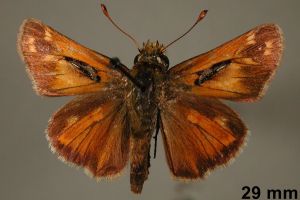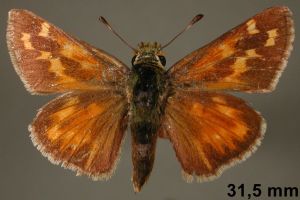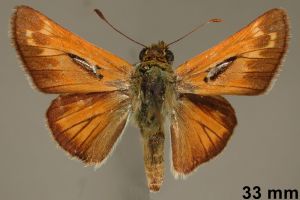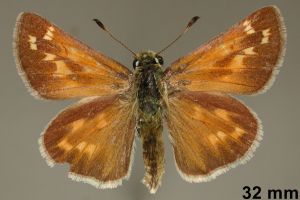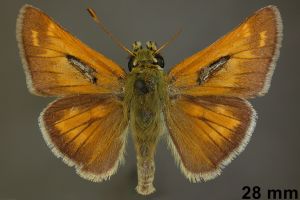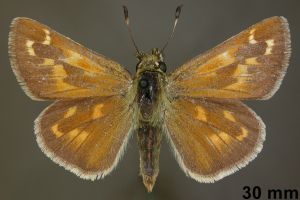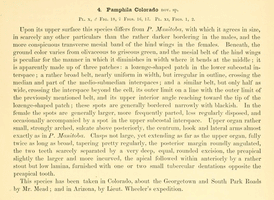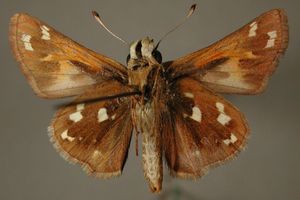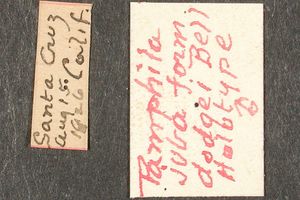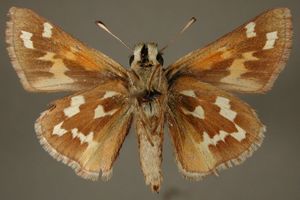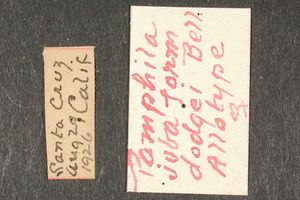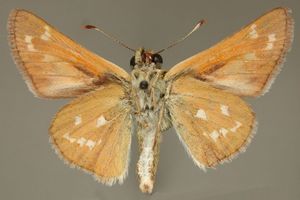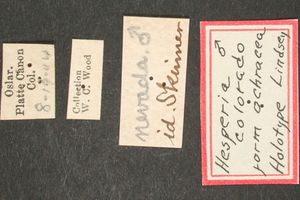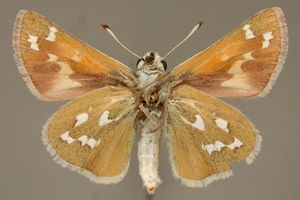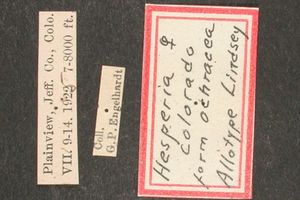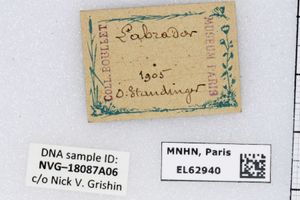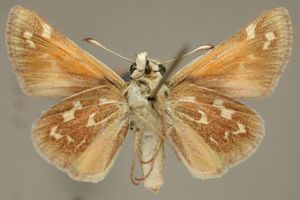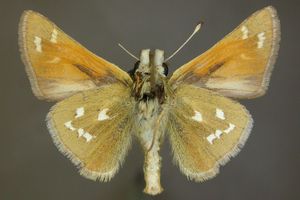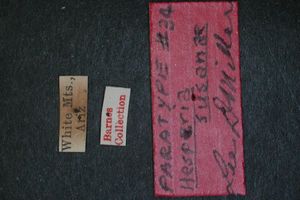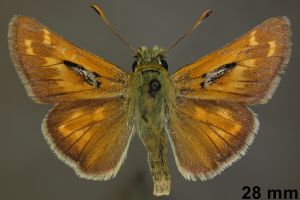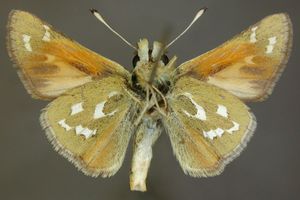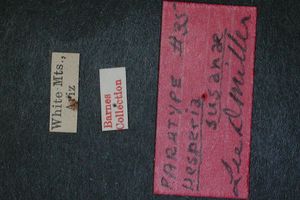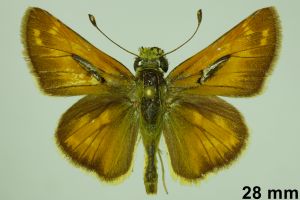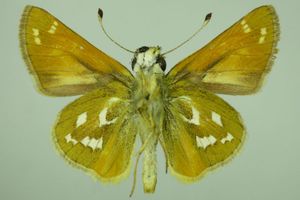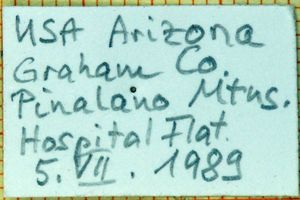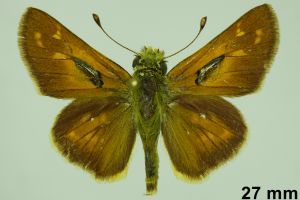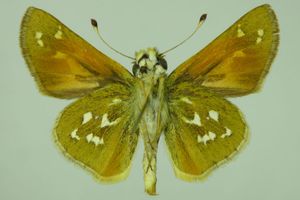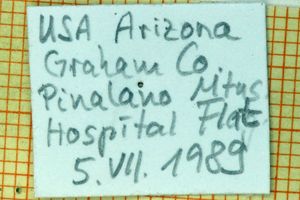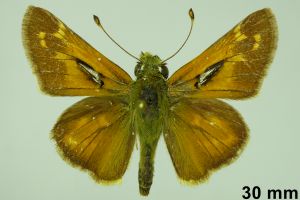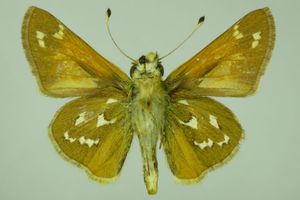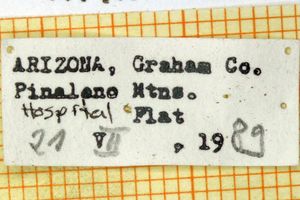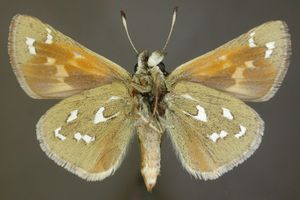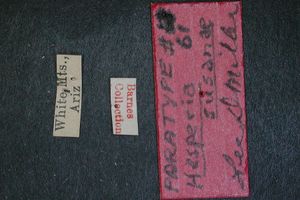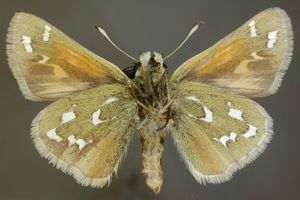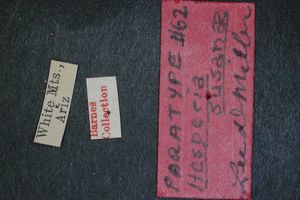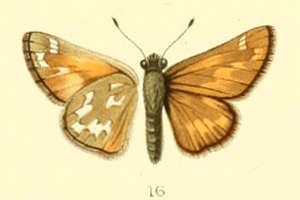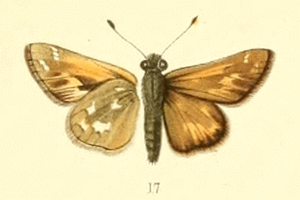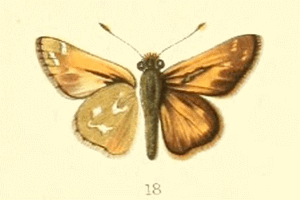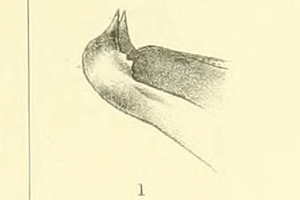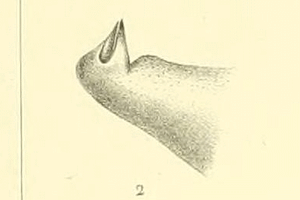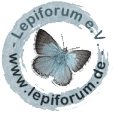

 +2Kontinente:NA
+2Kontinente:NA2. Diagnose
2.1. Ssp. manitoba
2.1.1. Männchen
2.2. Ssp. dodgei
2.2.1. Männchen
2.2.2. Weibchen
2.3. Ssp. ochracea
2.3.1. Männchen
2.3.2. Weibchen
2.4. Ssp. borealis
2.4.1. Männchen
2.5. Ssp. tildeni
2.5.1. Männchen
2.5.2. Weibchen
2.6. Ssp. susanae
2.6.1. Männchen
2.6.2. Weibchen
2.7. Erstbeschreibung
3. Biologie
3.1. Nahrung der Raupe
- [Poaceae:]: Anthoxanthum odoratum (Gewöhnliches Ruchgras)
Auf [Art Shapiro's Butterfly Site (abgefragt 29. September 2025)] ist zu Hesperia colorado harpalus zu erfahren: "Larvae feed on perennial grasses. Oddly, the only host definitely identified at one of our sites is a naturalized exotic, Sweet Vernal Grass (Anthoxanthum odoratum)." Bei den anderen im Internet herumgeisternden Süßgras-Arten ist in der Regel unklar, ob es sich um Freiland- oder Zuchtbeobachtungen handelt - oder überhaupt nur um Vermutungen. Dass die Art Süßgräser nutzt, ist allerdings klar. Die längste Auflistung findet sich im [Montana Field Guide]: "Larval food plants are grasses, including Achnatherum, Andropogon, Anthoxanthum, Bromus, Bouteloua, Festuca, Lolium, Muhlenbergia, as well as Elytrigia, Poa, and Setaria in captivity; also sedges, including Carex (Scott 1986, 1992, 2006; Layberry et al. 1998; Pyle 2002; Shapiro and Forister 2005; James 2009; James and Nunnallee 2011)."
(Autor: Erwin Rennwald)
4. Weitere Informationen
4.1. Andere Kombinationen
- Pamphila colorado Scudder, 1874 [Originalkombination]
4.2. Synonyme
- Erynnis comma colorado (Scudder, 1874)
- Hesperia comma colorado (Scudder, 1874)
- Pamphila manitoba Scudder, 1874
- Erynnis comma manitoba (Scudder, 1874)
- Hesperia comma manitoba (Scudder, 1874)
- Hesperia hulbirti Lindsey, 1939
- Hesperia comma hulbirti (Lindsey, 1939)
- Hesperia harpalus hulbirti (Lindsey, 1939)
- Hesperia comma borealis Lindsey, 1942
- Pamphila manitoba var. laurentina Lyman, 1892
- Hesperia laurentina (Lyman, 1892)
- Hesperia comma laurentina (Lyman, 1892)
- Erynnis comma laurentina (Lyman, 1892)
- Hesperia comma oroplata Scott 1981
4.3. Unterarten
- Hesperia colorado manitoba (Scudder, 1874)
- Hesperia colorado harpalus (Edwards, 1881)
- Hesperia colorado idaho (Edwards, 1883)
- Hesperia colorado oregonia (Edwards, 1883)
- Hesperia colorado laurentina (Lyman, 1892)
- Hesperia colorado dodgei (Bell, 1927)
- Hesperia colorado hulbirti (Lindsey, 1939)
- Hesperia colorado leussleri Lindsey, 1940
- Hesperia colorado borealis (Lindsey, 1942)
- Hesperia colorado ochraceaLindsey, 1941
- Hesperia colorado tildeni Freeman, 1956
- Hesperia colorado susanae Miller, 1962
- Hesperia colorado mojavensis Austin & McGuire, 1998
- Hesperia colorado mattoonorum Austin & McGuire, 1998
- Hesperia colorado sublima Warren & Calhoun, 2015
4.4. Taxonomie und Faunistik
Die hier angeführten Unterarten manitoba Scudder, 1874, laurentina Lyman, 1892, hulbirti Lindsey, 1939 und borealis Lindsey, 1942 wurden alle auch schon Hesperia comma zugeordnet. Spätestens seit Cong et al. (2021) ist aber klar, dass Hesperia comma in Amerika auf einen ganz kleinen Zipfel Alaskas beschränkt ist, und dass alle anderen H. comma-ähnlichen Falter - sofern sie nicht eigene Arten darstellen - zu Hesperia colorado gehören. Dies gilt ausdrücklich auch für die 4 hier genannten Unterarten. Cong et al. (2021) konnten bei ihren umfangreichen genetischen Studien - auch an sehr alten Tieren - die lange umstrittene Typenlokalität nachträglich noch recht genau rekonstruieren - klar war davor nur, dass die Art von irgendwo aus dem Bereich der Unterarten sublima Warren & Calhoun, 2015, ochracea Lindsey, 1941, idaho Edwards, 1883 und oroplata Scott 1981 stammen müsste: "These four subspecies intergrade at the boundaries of their ranges, forming hybrids (fig. 1e). Hybridization patterns are best revealed by the PCA analysis, where the hybrids line up between the centers of populations (along dotted lines in fig. 1a). The transition between the alpine (red) and Arkansas River Basin (blue) populations is in Lake County (cyan numbers in fig. 1a), where three subspecies meet and hybridize. The lectotype of colorado (no. 45 fig. 1a) is sur rounded exclusively by the specimens from Lake County, implying where it was collected. Moreover, the mitogenome of the lectotype was a 100 % match to a single specimen (fig. 2c), which was more recently collected near Twin Lakes in Lake County. Another of Mead’s specimens (no. 49, a paralectotype of colorado, fig. 1a), also collected during his 1871 expedition, maps to the same area. STRUCTURE (fig. 1e) reveals their genomic composition. Lake County specimens are characterized by having some sublima (red) and idaho (green) components, making them attributable to the narrow geographic zone of transition between these populations. Nevertheless, as t-SNE shows (fig. 1c), the lectotype of colorado clusters within the Arkansas River Basin population, and STRUCTURE reveals that only a minor fraction of its genome is of hybrid origin. A portion of this population was described by Scott (1981) as a subspecies named H. c. oroplata (no. 44 is its holotype), but the entire population represents the nominotypical subspecies, H. c. colorado, which is the older name, superseding oroplata, a younger name (Scott 1981)."
(Autor: Erwin Rennwald)
4.5. Literatur
- Cong, Q., Shen, J., Zhang, J., Li, W., Kinch, L.N., Calhoun, J.V., Warren, A.D. & N.V. Grishin (2021): Genomics Reveals the Origins of Historical Specimens. — Molecular Biology and Evolution, 38 (5): 2166–2176. https://doi.org/10.1093/molbev/msab013. [zum open-access-Artikel mit Download auf academic.oup.com]
- Erstbeschreibung: Scudder, S. H. (1874): The Species of the Lepidopterous Genus Pamphila. — Memoirs read before the Boston Society of Natural History 2: 341-353, pl. X-XI. — Digitalisat auf biodiversitylibrary.org: [349], [353], [pl. X figs. 16-18], [pl. XI figs. 1-2]




